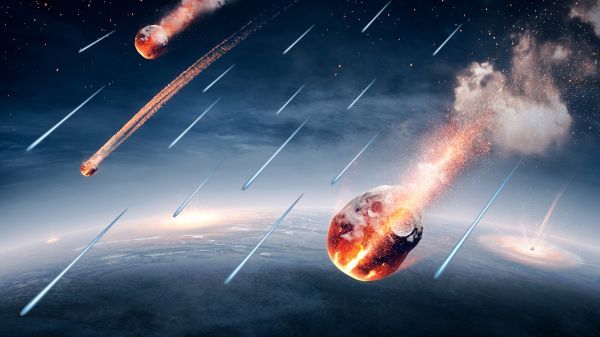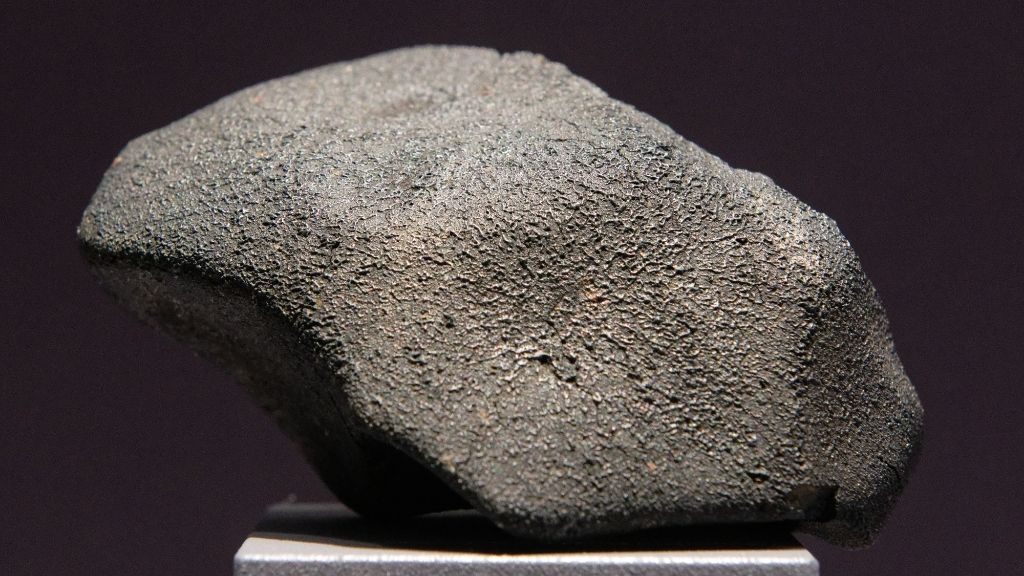The Murchison meteorite contained the building blocks of DNA and RNA, as did several other meteorites scientists investigated. (Image credit: Marie-Lan Taÿ Pamart, CC BY 4.0 , via Wikimedia Commons )
Scientists recently discovered that the remains of three meteorites include the molecular building blocks of DNA and RNA. Until now, a subset of these building components had been identified in meteorites, but the rest of the collection remained inexplicably missing from space rocks — until now.
The new finding lends credence to the notion that, 4 billion years ago, a shower of meteorites may have brought Molecular Building Blocks (MBBs) necessary to start life on Earth’s surface.
However, not everyone is convinced that all of the discovered DNA fragments are extraterrestrial in origin; rather, some may have arrived on Earth after the rocks made contact, according to Michael Callahan, an analytical chemist, astrobiologist and associate professor at Boise State University who was not involved in the research. “Further research is needed to rule it out,” Callahan said in an email.
A class of compounds known as pyrimidines was found in “extremely low concentrations”in the meteorites, which hints that instead of an influx of DNA components from space , the world’s first genetic molecules emerged as a result of geochemical processes unfolding on early Earth, he said.
According to Jim Cleaves, president of the International Society for the Study of the Origin of Life and geochemist who wasn’t involved in this study, it’s hard to say what level of concentration DNA building blocks meteorites would’ve needed to have possessed in order help drive forth life on Earth.
However, this is something that astrophysicists Jackie Green, Bonnie Buratti and Don Yeomans are investigating as they deep-dive inside nuclei comet structures searching for answers regarding where Earth’s water – and possibly even some aspects related to origin of life itself – could’ve come from.
The building blocks of Life in space rocks
Although it might sound like something out of a science fiction movie, nucleobases (the nitrogen-containing compounds that serve as the “letters” in the genetic code of our DNA and RNA) have been discovered in meteorites before. Adenine (A), thymine (T), guanine (G), cytosine (C) and uracil(U) are five primary flavors of nucleobases, but up until now, only A, G and U have been found in meteorites.
A study published on April 26th in the journal Nature Communications, revealed that all five nucleobases were found inside carbon-rich meteorites. This included cytosine, uracil, and thymine (the three pyrimidines) in trace amounts. According to first author Yasuhiro Oba, an associate professor at the Institute of Low Temperature Science at Hokkaido University in Japan, the detection of significant levels of cytosine was most unexpected because it’s generally unstable and reacts poorly with water.
Although thymine and cytosine had not previously been discovered in meteorites, laboratory research indicated that these nucleobases may be hiding undetected in the asteroids that struck our planet.
Researchers have recreated the chemical conditions of interstellar space — the space between stars — where enormous clouds of gas and dust measure around 10 kelvins (-441.67 degrees Fahrenheit, or -263.15 degrees Celsius) and parent asteroids of meteorites may be found in lab settings. Researchers synthesized thymine, cytosine, and the other primary nucleobases during these trials, implying that all of them could potentially be detected in meteorites, according to the study’s authors.
Read More: This may be life’s ‘missing ingredient’
Thus, the team set out to look for these nucleobases in three common meteorites. “Murchison, Murray and Tagish Lake meteorites are a type of meteorite called carbonaceous chondrites,” Callahan said. “This class is known to have lots of organic compounds.”
For example, hydrocarbons and the building blocks of proteins (amino acids) had been identified in the three meteorites, Oba said. Additionally, Oba and his colleagues detected an elusive molecule called hexamethylenetetramine (HMT), which is thought to be a precursor to organic molecules, in the space rocks according to NASA.
The findings showed that every meteorite had adenine and guanine. The Murchison samples also held uracil, while the others had at least one uracil isomer (a compound with the same number/type of atoms as uracil but arranged differently). Also, the Murchison & Tagish Lake specimens contained thymine–Murray’s held thymine isomers. Lastly, all meteorites carried cytosine plus different isomers of that compound.
Still uncertainty

To verify that the nucleobases were extraterrestrial in origin rather than a result of terrestrial contamination, the researchers repeated the experiment methods with no meteorite material in the test chambers. During these so-called “blank” studies, no nucleobases were observed.
The group also had ground samples from the location where the Murchison meteorite first came down to Earth. They discovered some nucleobases in the dirt, but “their placement and strengths are definitely not those found in meteorites,” Oba said. Also, certain isomers occurred only in space rocks and not soil specimens; these “odd isomers” seldom show up on Earth and are less likely to be pollutants from our planet’s surface, Cleaves noted.
Oba and his team compared the diversity of nucleobases found in a meteorite to that found on Earth, concluding that the compounds in the space rock must have formed outside our planet. They believe that these nucleobases “contributed to the emergence of genetic properties for the earliest life on Earth,” as they wrote in their study.
Callahan stated that there is still some uncertainty on these points, however.
Related: DNA just one of more than 1 million possible ‘genetic molecules,’ scientists find
According to the researchers, the soil sample they analyzed had higher levels of cytosine, uracil, and thymine than they’d seen in the Murchison meteorite “so it’s difficult to know how much is extraterrestrial versus terrestrial in the meteorite,” Callahan added. Furthermore, the team was unable to identify a particular chemical reaction that would produce C, U, T, and their various isomers; such an examination might have bolstered the concept that all of these chemicals were formed in space.
RELATED STORIES
READ MORE: Meteorite that landed in Botswana tracked to its birthplace in the asteroid belt
READ MORE: 4.6 billion-year-old meteorite found in horseshoe footprint
READ MORE: Rare meteorite, a ‘relic of the early solar system,’ falls on a driveway in England
Another way to determine whether the nucleobases are extraterrestrial is to examine their carbon and nitrogen composition, Cleaves said. These elements come in different flavors, called isotopes, which have the same numbers of protons but different numbers of neutrons. Earth-bound matter contains different ratios of carbon isotopes and nitrogen isotopes than space-faring matter, so such analyses could help identify terrestrial nucleobases from those originating outside our atmosphere, Callahan said. Unfortunately, such investigations need a significant quantity of meteorite material to run, making them difficult to accomplish.
Even if the C, T and U that were detected are extraterrestrial, their rare presence in meteorites raises questions about the theory that DNA components from space might have seeded the first life on Earth, said Callahan. “If these results reflect normal pyrimidine concentrations in meteorites,” he said, “then it’s more likely that chemical processes on early Earth gave rise to genetic material instead of contributions from outer space.”
In the future, Oba and his colleagues plan to collect nucleobases from asteroids themselves rather than meteorites on Earth. This could minimize contamination from Earth-born substances. For example, as Live Science previously reported, the Japanese spacecraft Hayabusa2 recently brought the asteroid Ryugu down to Earth. Similarly, NASA’s OSIRIS-REx probe is due to touch down with samples of Bennu in 2023, Space.com reports.

